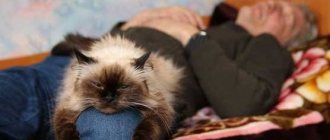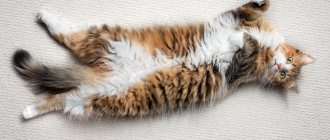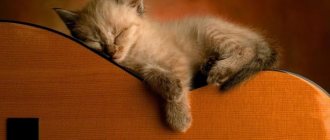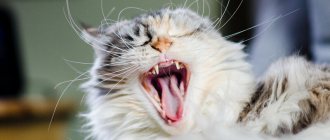Perhaps there is not a single indifferent person who would not be touched by the purring of a cat. It is this that gives the coziness that is so characteristic of cats. This contented, purring creature attracts mysterious, fascinated glances. Some owners suggest that in this way cats tell them bedtime stories and share their daytime adventures. In our article we will try to reveal in more detail such questions as why cats purr, and what physiological reasons allow them to do this.
How to properly pet a cat: top 8 “purrr tricks”
Does your cat not like affection?
Maybe you don’t know how to stroke it properly yet? There are 8 sensitive places on a cat's body, stroking or scratching which will make the animal purr with pleasure. You know about this technique for sure. Many cats deliberately expose their ears to us, rubbing their heads against our hands, if only a person would scratch behind the base of their ears. There the cat has thinner and thinner fur, which makes it more sensitive to touch. In addition, cats have scent glands behind their ears. By touching them, you, without knowing it, leave a mark on yourself that you “belong” to this cat.
If the cat trusts you, he will happily put his neck, neck and chin under your hand. You need to scratch these areas very gently and carefully so that the animal does not decide that you want to grab it by the throat.
The next sensitive area, scratching which will bring pleasure to the cat. The reason is the same - due to the sparse fur, you touch the animal’s skin with your fingertips, which gives it an unusual sensation.
There are even more scent glands and receptors on a cat's cheeks than behind the ears. But whiskers also grow here, which you need to be very careful with. Cats really don't like to be touched or have their whiskers pulled.
Many cats feel blissful when they are petted and scratched on the back. But don't go against the grain! Run your hand from the animal's neck and further along the back - the kitty will purr with pleasure. Often cats also expose their sides to be scratched, stroked and lightly patted.
There are no scent glands on the cat's abdomen, but there are many sensory zones. However, the beast allows only a select few to touch its belly. If the pet is lounging on its back with its belly up, do not be fooled - this is not an invitation to pet it at all: in this way the cat is resting and showing you its trust. Even if the cat trusts its belly, always keep an eye on its tail. If he is tense, and even more so walks from side to side, it means that the animal no longer likes your caresses and is about to grab your hand.
There are cats who find happiness when they are scratched on the back closer to the base of the tail. But you shouldn’t touch the tail itself, much less pull it - the cat will immediately release its scratches.
A cat's pads are practically a full-fledged sensory organ, there are so many receptors on them. But not every cat will allow you to touch its paws and fingers. If the animal hits its tail, stop tickling the pads immediately. And if, on the contrary, he spreads his fingers and purrs, it means he liked the tickling.
(This article uses images with a free license)
Thanks for liking and subscribing!
Does your pet constantly run away?
Do you want to know where he is wandering and find him in time? Then order him a Petsee GPS collar on the official website
Source
Why does a cat purr?
Of course, everything regarding the question of why cats meow and purr remains only against the backdrop of assumptions and guesses. Here are just some of the common versions of the question why pets purr:
- A way of expressing emotions. This is how the kittens communicate with their mother cat. They seem to tell her that everything is fine with them. This is especially important for a cat family when they are separated for a while.
- Calm. Kittens often purr at the moment when they suck their mother's milk, and the mother cat also calms and encourages them with a similar sound.
- Contentment and gratitude. It is often noticed that a pet, having received its due share of yummy food, makes this mesmerizing sound as a sign of gratitude. The cat is happy with his life and purrs with pleasure.
- Good mood. If the animal is in good spirits, then it seems to hum to itself, rejoicing at the peace and the fact that everything has worked out.
- Purring helps a cat regain its strength after suffering stress. Sound vibrations normalize blood circulation and force the immune system to work in enhanced mode. Thus, the cat warms up at a time when it feels cold, and it calms down after a stressful situation. At this time, he should not be distracted from this activity, as it forces the body’s reserve forces to work.
- When meeting another cat, the pet purrs to show its disposition towards her, its good nature and interest.
- Such a sound can sometimes personify the cat’s cunning; he is able to beg in this way for a tasty treat or affection; sometimes the pet, knowing the owner’s weaknesses, can use purring to ask to enter the owners’ bedroom.
- If the purring is pronounced with an unusual volume, then, most likely, the pet experienced a feeling of fear.
- Sometimes such a sound helps the cat get ready for rest and sleep at night. She seems to achieve peace of mind and harmony.
- If the purr is pronounced with a threatening intonation, then the cat is protecting its territory in a similar way; it is not only determined to protect its home, but also to self-defense.
- The hunter's instinct can manifest itself in a similar way. The cat can purr loudly, following the movements of birds outside the window, as if he is enjoying an imaginary hunt.
Why do cats purr and what does it mean?
Why do you think your cat purrs? Shows his love? Asking for your favorite treat? Attracts attention? Yes, but not only for that reason.
What does your cat's purring mean? Do all cats purr and why might a cat suddenly stop purring? You will learn the answers to these questions from our article.
Cats have conquered the whole world. And the gentle purring definitely helped them with this! Did you know that purring is not only pleasant music for our ears, but also has health benefits?
Numerous studies by American scientists (*researchers Robert Eklund, Gustav Peters, Elizabeth Duthie from the University of London, animal communication specialist Elizabeth von Muggenthaler from North Carolina and others) have shown that the purring sounds and vibrations of a cat’s body have a positive effect on human health. They calm you down, even out your breathing and heart rate, eliminate stress and insomnia, and even strengthen your bones! It's no surprise that cats are the stars of pet therapy.
How do cats purr?
Have you ever wondered where the organ responsible for purring is located in a cat? What processes take place in the body for us to hear the cherished “purrr”? How do cats do it anyway?
The purring process originates in the brain: electrical impulses arise in the cerebral cortex. They are then “thrown” onto the vocal cords and cause them to contract. The vocal cords move, alternately narrowing and widening the glottis. And then the fun part. The cat has a special purring organ - the hyoid bones. When the vocal cords contract, these bones begin to vibrate - and that’s when you and I hear the treasured “urrrrr”. Usually the “purr” occurs when the cat exhales, and its body pleasantly vibrates to the beat.
Cat purring - real sound therapy
We have already mentioned that cats often lie down on the owner’s sore spot and begin to purr. An animal can, for example, lie on the owner’s legs if they are “whining” about the weather. Or even lie on your head when the owner is tormented by a migraine. What does this mean, can pets really heal? It turns out that the purring of cats is therapeutic sound therapy.
A measured, quiet sound calms frayed nerves no worse than the sound of rain or the sound of a babbling stream. Felinologists believe that cats, with the help of special rumbling sounds, can treat the following ailments:
Bone fractures, joint and muscle pain;
Nervous disorders (depression, stress);
Diseases of the heart and blood vessels;
Various inflammatory processes;
Diseases of the stomach and/or intestines;
Even though the sounds of rumbling help relieve, for example, joint pain or lower blood pressure, such sound therapy cannot be considered a full-fledged treatment; you will still need the help of a doctor.
However, a cat's purring fights well against the same fatigue and nervousness. Anastasia Morozova Updated: 03/18/2019 Cat owners have heard purring sounds from their pets more than once. This sweet lullaby brings a sense of coziness and comfort to a person. Why do our little four-legged friends purr and how does this happen?
- How does purring happen ↓
- Why does a cat purr ↓
- The benefits of purring ↓
- Cat massage ↓
- The most purring breeds ↓
What to do if your cat's urinal is broken
What does your pet want to say when it purrs? Why do cats make these sweet and soothing sounds? And what is the reason that your pet suddenly stopped purring?
How do cats purr?
Today, the main version is that a certain part of the cat’s brain is responsible for rumbling.
, sending impulses directly to the vocal cords, which begin to vibrate, appearing on the hyoid bones, and spreading vibration throughout the body.
Why do cats do this?
- Expression of feelings and emotions. "I purr when I'm doing well"
- To heal wounds and calm down. “I can purr if something hurts me.”
- "I'm completely calm"
- “I want a treat, or for you to pay attention to me”
- “I appreciate the treat and that you treat me well.”
All of these reasons are united by the fluffy’s love for his person and his complete trust in you.
What to do if the cat no longer purrs
Determine the cause of this phenomenon.
In some cases, by not purring, your pet may simply be showing character. Or show offense. (If your pet has suffered undeservedly, apologize to the cat: take him in your arms, stroke him, treat him with your favorite treat)
If the absence of purring is accompanied by apathy, lack of playfulness, poor appetite and lethargy, you should immediately contact a veterinarian.
Interesting facts about cat purring
- Cats don’t purr; if there is another cat in the room, they don’t need this type of communication. That is, they purr alone with themselves or with a person.
- Not only animals, but also humans benefit from rumbling, since this sound and vibration of cats when you pet them have a positive effect on the human body. (can relieve fatigue, apathy, headache, in some cases even normalize blood pressure)
- A purring animal's heartbeat cannot be heard, so veterinarians have to wait for the cat to calm down, or turn on the water to distract it.
The mechanism of sound production when purring
Some scientists put forward their theories about the source of rumbling, offering the following options.
Vocal cords are used by cats to meow, which humans hear when the animal makes the sound with its mouth open. If it is closed, then the vibration, which occurs due to the same work of the ligaments and throat, touches a special bone located under the tongue.
The sinuses increase vocal resonance. When an animal's mood changes, the speed of blood flow increases, that is, a change in blood pressure occurs. Vibration of the chest causes vibrations, which are converted into sound in the sinuses.
The involvement of the lungs in the process was established through observation of animals: purring is not the same when inhaling and exhaling.
Why and how do cats make purring sounds?
Why do cats purr? How is this sound produced? What to do to make a cat purr. Let's take a closer look at these questions about purring pets.
Purring is a sound that is produced only by the family of feline animals. They can do this with a certain rhythm, varying volume and varying time and duration. A cat's mouth and nose are where sound comes from.
Scientists explain this by the presence of certain muscles located near the animal’s vocal cords. Under different conditions, these muscles begin to contract rapidly, creating the vibration and sound that people are so accustomed to hearing from their pet.
What is purring like?
Purrs vary in volume and duration of sound. If a cat makes a loud noise, it could signal problems or negative emotions, such as being unhappy or scared.
Loud and short-lived purring can be a sign of hunger. If the loud purring does not stop for a long time, there is a possibility that the animal is in pain.
When a cat is relaxed and calm, it makes a quiet and soft sound. In this case, the purring lasts a long time.
What does it mean when cats purr?
When an animal makes its internal vibrating sound, it communicates its good intentions through its behavior. Or feels positive emotions towards the environment. The volume with which they purr expresses the completeness of the animal’s sensations.
The reasons for purring in a cat can be completely different, the main ones are:
- - Feels completely safe, for example, when falling asleep;
- — The desire to attract the attention of the owners, perhaps to be fed;
- — When communicating with animals, if it is not a fight for territory;
- - When they receive affection from the outside world;
- — Greeting the owners when they returned home;
- — Any manifestation of care for your kittens.
Another theory says that when cats begin to purr, they give a signal to other animals, letting them know that they are completely peaceful. For example, a cat who lives in a house with a dog can behave this way.
Why do kittens purr?
British scientists have found that cats can purr starting from the age of two days. In this way they signal to their mother that they are hungry or afraid of something. This is a unique way of communication between kittens and an adult cat. We can say that they speak such a unique language.
Thus, the cat often leaves her kittens to eat. If she is in the wild, then approaching her nest, she begins to purr, thereby informing her kittens that there is no need to squeak, she is nearby and is already approaching the house. At the same time, kittens may purr in response. This happens especially often if the cat licks them and cares for them. This is a kind of gratitude, the kittens seem to tell her that they are warm, good and very happy. Zoologists believe that such purring of small kittens stimulates lactation in a cat and provokes it to better care for its offspring.
Cat
As you can see, cats purr for a variety of reasons. If, during prolonged petting, your pet does not purr, but ignores you, you should think about the psychological comfort of the animal. Perhaps the cat is dissatisfied with something or feels negative emotions on your part.
The benefits of purring for people and cats.
Science has put forward several theories in this regard.
- 1. The effect of vibration and the sound of purring produces a certain hormone in cats, which acts as an analgesic and relaxing effect on the animal’s brain;
- 2. The vibration of the rumbling has a certain frequency, which strengthens the animal’s own bones. Perhaps this is why wounded or sick cats purr. Even during sleep, the animal’s bones and muscles are in good shape;
- 3. For humans, the purring of a cat can also be a good medicine. The frequency range of the rumbling is from 21.98 Hz to 23.24 Hz. It is in this interval that medicine uses means to strengthen human muscles and bones;
- 4. Strengthening the nervous system is another healing property of cats. This Sound has the property of calming the human nervous system.
It's no surprise that the feline family is one of our favorite pets. Who love to cuddle up to their owners and are exemplary house pets.
Source











